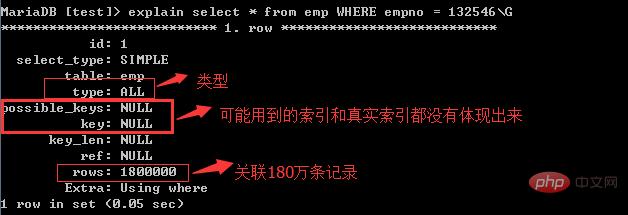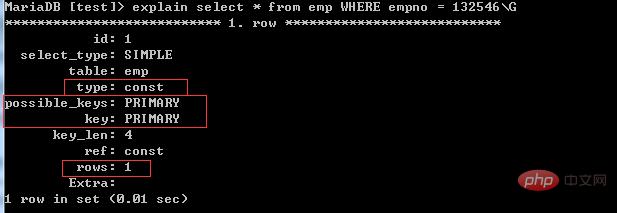SQL是Structured Query Language(结构化查询语言)的缩写。SQL是专为数据库而建立的操作命令集,是一种功能齐全的数据库语言。在使用它时,只需要发出“做什么”的命令,“怎么做”是不用使用者考虑的。SQL功能强大、简单易学、使用方便,已经成为了数据库操作的基础,并且现在几乎所有的数据库均支持SQL。 本篇文章给大家带来的内容是mysql索引是什么?浅谈mysql索引,让大家对mysql索引有一个简单的了解。有一定的参考价值,有需要的朋友可以参考一下,希望对你们有所帮助。一:什么是索引 索引本身是一个独立的存储单位,在该单位里边有记录着数据表某个字段和字段对应的物理空间。索引内部有算法支持,可以使查询速度非常快。【相关视频教程推荐:mysql教程】 
有了索引,我们根据索引为条件进行数据查询,速度就非常快 1,索引本身有“算法”支持,可以快速定位我们要找到的关键字(字段) 2,索引字段与物理地址有直接对应,帮助我们快速定位要找到的信息 一个数据表的全部字段都可以设置索引 二,索引类型 1,四种类型: (1) 主键 parimary key 必须给主键索引设置auto_increment,索引列的值要求不能为null,要唯一 (2)唯一 unique index 索引列的值不能重复,但允许有空值 (3)普通索引 index 索引列的值可以重复。 (4)全文索引 fulltext index Myisam数据表可以设置该索引 2,复合索引 索引是由两个或更多的列组成,就称复合索引或联合索引。 三,创建索引 1,创建表时 1),创建一个member表时,并创建各种索引。 create table member(
id int not null auto_increment comment '主键',
name char(10) not null default '' comment '姓名',
height tinyint not null default 0 comment '身高',
old tinyint not null default 0 comment '年龄',
school varchar(32) not null default '' comment '学校',
intro text comment '简介',
primary key (id), // 主键索引
unique index nm (name), //唯一索引,索引也可以设置名称,不设置名字的话,默认字段名
index (height), //普通索引
fulltext index (intro) //全文索引
)engine = myisam charset = utf8; 2),给现有数据表添加索引 //注:一般设置主键后,会把主键字段设置为自增。(alter table member modify id int not null auto_increment comment '主键';)
alter table member add primary key(id);
alter table member add unique key nm (name);
alter table member add index(height);
alter table member add fulltext index(intro); 3),创建一个复合索引(索引没有名称,默认把第一个字段取出来作为名称) alter table member add unique key nm (name,height); 2,删除索引
alter table 表名 drop primary key;//删除主键索引 注意: 该主键字段如果存在auto_increment 属性,需要先删除。(alter table 表名modify 主键 int not null comment '主键') 去除去数据表字段的auto_increment属性; alter table 表名 drop index 索引名称; //删除其它索引(唯一,普通,全文) 例: alter table member drop index nm; 四、explain 查看索引是否使用 具体操作: explain 查询sql语句 这是没有设置主键索引的情形:(执行速度、效率低) 
加上主键后: 
五、索引适合的场景 1、where查询条件(where之后设置的查询条件字段都适合做索引)。 2、排序查询(order by字段) 六、索引原则 1、字段独立原则 select * from emp where empno = 1325467;//empno条件独立,使用索引
select * from emp where empno+2 = 1325467;//empno条件不独立,只有独立的条件字段才可以使用索引 2,左原则 模糊查询,like & _ %:关联多个模糊内容 _:关联一个模糊内容 例: select * form 表名 where a like "beijing%";//使用索引
select * from 表名 where a like "beijing_";//使用索引
select * from 表名 where a like "%beijing%”;//不使用索引
select * from 表名 where a like "%beijing";//不使用索引 3,复合索引 index(a,b) select * from 表名 where a like "beijing%";//使用索引
select * from 表名 where b like "beijing%;//不使用索引
select * form 表名 where a like "beijing%" and b like "beijng%";//使用索引 4,or原则 OR左右的关联条件必须都具备索引,才可以使用索引。 例:(index(a)、index(b)) select * from 表名 where a = 1 or b = 1;//使用索引
select * from 表名 where a = 1 or c = 1;//没有使用索引 总结:以上就是本篇文章的全部内容,希望能对大家的学习有所帮助。 以上就是mysql索引是什么?浅谈mysql索引的详细内容,更多请关注php中文网其它相关文章!
学习教程快速掌握从入门到精通的SQL知识。
| 

